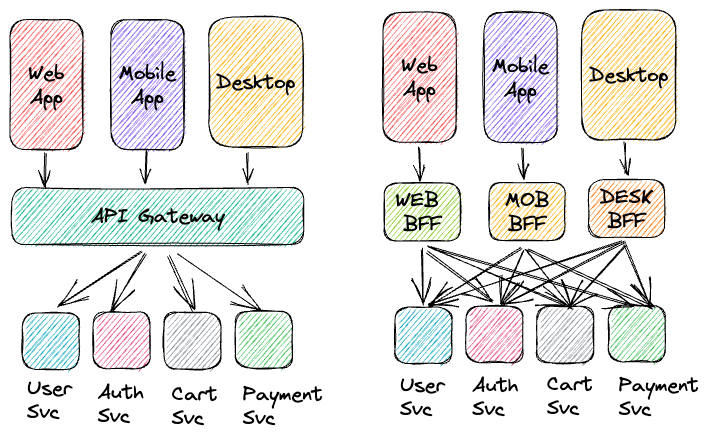Backends for Frontends (BFF) Pattern: Architecture Pattern
The Backends for Frontends (BFF) pattern is an architectural pattern that involves creating a separate backend service for each frontend.
The Backends for Frontends (BFF) pattern is an architectural pattern that involves creating a separate backend service for each frontend application. This pattern is often used in microservices architectures, where each service is responsible for a specific function.
Following the BFF pattern doesn’t mean you’re creating a new backend, but rather that you’re creating an abstraction, which will be known to your frontend.
The BFF Pattern proposes the creation of a layer that acts as an intermediary between frontends and underlying microservices, aggregating and transforming data to meet the specific requirements of each platform. The BFF pattern is best used in situations where there are multiple front-end applications that have different requirements.
For example, a company might have a mobile app, a web app, and a native desktop app. Each of these applications might have different requirements for data access, caching, and security. In this situation, the BFF pattern can be used to create a separate backend service for each front-end application. This can help to ensure that each frontend application gets the data it needs, in the format it needs, and in a way that is secure.
Advantages of the BFF Pattern:
Better alignment between frontend and backend teams: The BFF pattern can improve alignment between frontend and backend teams by giving each team ownership of a specific service. This can lead to better communication and collaboration between the teams, as well as a better understanding of the needs of each other. In addition, you can have independent releases per frontend and different API versions across different frontends.
Improved performance: The BFF pattern can improve performance by caching data and making it available to the front-end application without having to request the back-end service. In addition, the BFF layer can transform the data into the exact format the front end needs to prevent more processing on the front end.
Improved scalability: The BFF pattern can improve scalability by allowing each front-end application to connect to its own BFF service. This can reduce the load on the backend services, as well as improve the performance of the frontend applications.
Enhanced security: By leveraging abstractions, it becomes possible to conceal sensitive information and exclude unnecessary data from the front end when responding to front-end requests. This heightened level of abstraction makes it increasingly challenging for attackers to specifically target the application, thus bolstering its security measures.
Disadvantages of the BFF Pattern:
Increased complexity: The BFF pattern can increase the complexity of architecture by adding layers of services. This can make it more difficult to manage and maintain the architecture.
Increased cost: The BFF pattern can increase the cost of an architecture by requiring additional resources, such as servers and storage.
Increased risk: The BFF pattern can increase the risk of architecture by introducing additional points of failure. It also increases latency as it leads to an extra hop.
This brings us to the end of this article. We talked about Backends for Frontends (BFF) pattern, and what its advantages and disadvantages are. It’s important to understand that the idea is to create a backend for each front-end to provide a better user experience, so please don’t follow this pattern if you have different OS ecosystems on mobile(ultimately the user experience across the ecosystem is that of a mobile user).
Also, if you notice, BFF’s an extension to an API Gateway or GraphQL, where a BFF is isolated to a single front-end. Hope you found this post useful & post comments on any doubts you might have and will be happy to discuss them!



